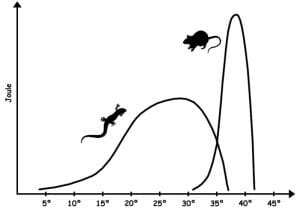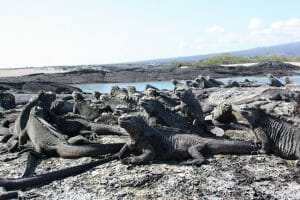Ectotherm Definition
An ectotherm is an organism which derives the heat it requires from the environment. This is in contrast to an endotherm, which creates the heat it needs from internal chemical reactions. A common misconception is that an ectotherm is “cold-blooded”. An ectotherm can regulate its temperature behaviorally, by moving into warmer areas or positioning themselves to reduce heat loss. Therefore, while many ectotherms allow their body temperatures to drop during periods of inactivity, they usually maintain body temperatures in ranges similar to mammals while they are active. An ectotherm can be a thermoregulator or a thermoconformer, depending on if it actively changes its body temperature. There are also a number of pro and cons to being an ectotherm. These topics will be addressed below.
Thermoregulation in an Ectotherm
The common misconception around ectotherms being cold-blooded comes a misunderstanding of how these animals work. All animals need some sort of heat energy for the chemical reactions in their bodies to take place. Endotherms derive this heat from the breakdown of energy rich tissues like fats and through quick muscular contractions, known as shivering. These processes release heat, which is then distributed through the body via the circulatory system. Likewise, an ectotherm also uses the circulatory system to distribute the heat throughout its body, but the heat comes from a different source.
Instead of relying almost solely on the energy in their food for heat, ectotherms use radiant heat provided by the environment. This heat can be gained in many ways. Solar radiation is the most common way, as many ectotherms use the sun’s rays to warm up. Another way is through conduction. Rocks and the ground soak up solar energy, and over time they radiate that energy out in the form of infrared radiation. An ectotherm can also position itself near or on things that are radiating heat to absorb that heat. Thermoregulating ectotherms take advantage of this, and build their body heat up to substantial levels before periods of activity. Then, usually at nighttime, an ectotherm will let its body temperature drop, as it doesn’t need the extra heat. Evaporation of water and conduction of heat away from the organism cause heat loss. A thermoregulating ectotherm will also behavior adaptations to deal with these losses, such as hiding in a burrow or minimizing evaporation through body posture and breathing.
There are also thermoconforming ectotherms. A thermoconformer is an animal which does little to nothing to change its body temperature. A thermoconforming ectotherm is also known as a poikilotherm. Consider most fish for example. Water has the ability to sap heat out of an organism very quickly. As fish breathe, water passes directly over their gills and cools their blood. As a consequence, most fish are the same temperature as water around them. They do not shiver or bask in sunlight when they are cold, their maximum activity level simply decreases. Some ectothermic animals even live in freezing environments, and use specialized ions and antifreeze molecules to keep their cells from freezing. Others, like many invertebrates, simply freeze and wait to be thawed out. On the other end of the spectrum, there are also large fish like tunas and sharks which keep their body temperatures higher through specialized circulation patterns and high levels of activity. Some have even argued that these fish could be endothermic to a certain degree.
Thus, how an ectotherm can thermoregulate varies widely. There exists an entire spectrum within the category of ectotherm which includes all these methods of regulating temperature. That being said, very few ectotherms actually have “cold” blood. Compared to humans and other endotherms, they simply allow their body temperatures to fluctuate much more. While it may seem like endotherms are somehow “more evolved” or more complex, this is simply not the case. As all organisms alive today have been evolving for the same amount of time, the fact that there are both endotherms and ectotherms means that both systems have their benefits and faults. In fact, by number of species and overall biomass, the ectotherms far outweigh the endotherms. This is because being an ectotherm has a number of pros and only a few cons.
Pros and Cons of Being an Ectotherm
Pros
Ectotherms have a distinct advantage over endotherms when it comes to energy usage. Mammals typically use about 98% of their energy to maintain their body temperature. This means that they can maintain high activity levels nearly all the time, but it also means that they can only use about 2% of the energy in their food for growth and reproduction. An ectotherm does not have this problem. Most ectotherms use over 50% of the energy in their food for growth and reproduction. This means that ectotherms can survive on much less food than similarly sized endotherms. An ectotherm can simply let its body cool off at night, reducing the amount of food needed for survival. The graph below shows the ability of an ectotherm to survive over a wider variety of internal temperatures.
The ability to allow body temperature to fluctuate gives a number of other distinct advantages. A reduced body temperature means cellular processes go slower, decreasing the total metabolism. This is important for fish and other creatures which live in freezing waters over winter. All in all, it has been found that an ectotherm uses approximately one-tenth of the energy that an endotherm uses. These energy savings translate directly into faster growth and more reproduction. Where a bird may lay several eggs, a similarly sized reptile will lay hundreds. However, ectotherms also face distinct limitations.
Cons
Mammals and other endotherms developed for a reason: there was a niche to be filled that ectothermic animals could not compete in. Because ectotherms tend to lower their activity levels periodically, they are vulnerable to predation. Whether you are basking in the sun or falling asleep because your body temperature is dropping, many ectotherm behaviors are risky. Endotherms do not have this drop in energy level every day, and therefore are more ready to react to danger. Note of the graph above that this also means ectotherms have a lower overall activity level. While this is a major flaw, it has not stopped millions of ectotherms.
The second major problem that excludes ectotherms from certain environments is temperature. Many mammals and birds are able to live where ectotherms cannot. These animals use adaptations like hair and feathers to insulate themselves from temperature extremes. Other ectotherms, like those in the desert, have a hard time maintaining their water balance because it is directly tied to their heating and cooling mechanism. As seen in the examples below, many ectotherms have strange behavioral adaptations which allow them to compensate for these problems.
Examples of an Ectotherm
Galapagos Iguanas
The Galapagos iguana (Amblyrhynchus cristatus), also called the Marine iguana, is a perfect example of a thermoregulating ectotherm. In the morning, the iguana emerges from its burrow, and takes a position on a black lava rock. The iguana’s temperature is really low, as the iguana let it fall overnight. As the sun strikes the iguana and the rocks around it, the iguana absorbs the solar and infrared radiation striking its body. It will even turn the largest surface area of its body towards the sun, much like a solar panel, to absorb the maximum amount of heat. Eventually, the iguana is hot, and ready to be active, as seen in the image below. Marine iguanas are special in that they forage underwater for algae.
The iguana runs off the cliffs, and plunges into the cold ocean water. The water quickly starts drawing the heat out of the iguana’s body. It must hurry to feed before it is too cold to move its muscles. While the iguanas can hold their breath for over 30 minutes, they must return to the shore shortly after this to start regaining heat. The iguana returns to the surface after feeding, and swims to shore. It must now climb back up the cliffs and start reabsorbing heat. In this way, the iguana is actively regulating its temperature to provide itself with enough heat to efficiently feed. At night, the iguana will return to its burrow and assume a much lower body temperature, close to that of the air.
Tree Frogs
Tree frogs are an ectotherm which have a different set of problems. The rainforest is a very warm place, even at night. Most tree frogs do not necessarily have to lower their activity levels at night. Their temperature cycle is usually based on a different phenomenon: that of evaporation. During the day, trees absorb water from the ground and transfer it to the air above the canopy. By the afternoon, the air is saturated, and it begins to rain. This constant water cycle also affects the tree frogs. As the air dries out in the hottest part of the day, the water from the frog begins to evaporate away. This not only dries the frog out, but reduces the frog’s body temperature as well.
But tree frogs aren’t without their tricks. Some frogs will jump into bodies of water during this part of the day, as standing water is usually fairly warm and they won’t lose water to evaporation. Other frogs have adapted strange poses, which protect their most sensitive areas from losing water. Then, when the afternoon rains begin to come down, the frogs can begin hunting and feeding on insect. This times perfectly with the coming of nighttime, when many insects emerge.
Freezing Fish
The final example is of a non-regulating ectotherm. Several species of fish exist in waters so cold that normal fish would freeze. For water to become ice, it needs a couple of factors to exist. First, it must be cold enough. Second, there must be some sort of molecule which acts as a “seed” for ice crystals to establish on. Lastly, the water must not contain molecules which prevent ice formation. Fish which exist in these conditions are poikilotherms, or ectotherms which do not regulate. While these animals do not need much heat to maintain their activity levels, they do prevent themselves from freezing.
These animals both actively filter impurities from their blood and create special proteins which prevent ice from forming. This allows the animals to exist in temperatures far below freezing, with freezing themselves. Salt water doesn’t freeze until much lower temperatures because of the dissolved salts, but the water inside animal cells is much less salty, and should freeze before saltwater. A normal fish would freeze from the gills almost instantly in these waters. These fish prevent this from happening and are able to thrive in a niche others cannot reach.
Quiz
1. Which of the following is an ectotherm?
A. Zebra
B. Ostrich
C. Snake
2. What is one advantage of being an ectotherm?
A. You are warm all the time
B. You use considerably less energy to regulate your temperature
C. You can gather food at any temperature
3. You found a new animal. You monitor it throughout the day and see that its temperature fluctuates a lot. You also see that it actively moves itself to different positions when its temperature reaches certain extremes. This animal is a:
A. Poikilotherm
B. Endotherm
C. Ectotherm


